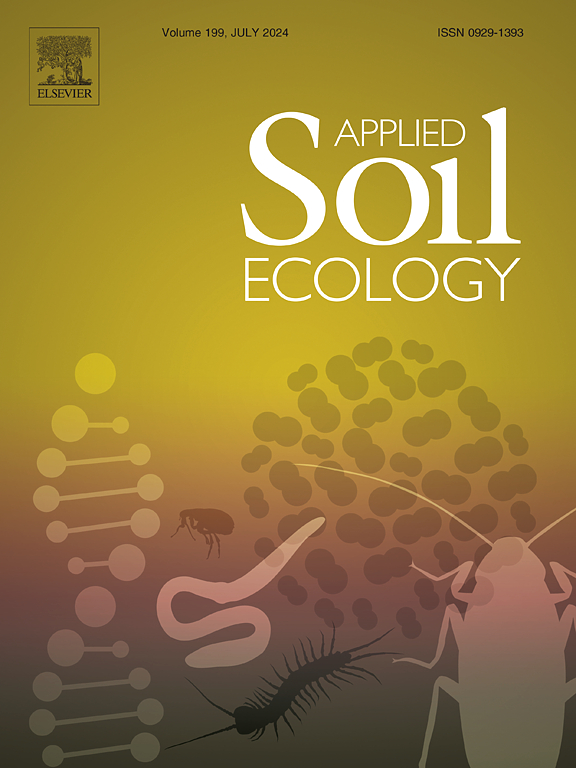作物轮作下微生物提高土壤全氮含量功能的宏基因组研究
IF 5
2区 农林科学
Q1 SOIL SCIENCE
引用次数: 0
摘要
豆科作物是重要的生物资源,可提高土壤全氮水平,有效改善微生物和植物营养,实现环境可持续的农业生产。然而,大豆种植后氮循环的具体过程和土壤微生物在提高全氮水平中的作用尚不清楚。本文以小麦-玉米(WM)、小麦-棉花(WC)和小麦-大豆(WS)轮作为研究对象,对土壤微生物氮循环基因进行了比较分析。12年后,WS处理比WC和WM处理分别提高了9.1%和19.4%的土壤TN含量,凸显出其独特的富氮效果。微生物群落分析表明,WS处理显著提高了Shannon和β-多样性指数,二者均与TN含量呈正相关。网络分析显示三个特征模块:模块1(以Proteobacteria/Actinobacteria为主)与TN无显著相关;模块2(以酸菌/蓝藻菌为主),负相关;与模块3(以Thaumarchaeota为主)呈正相关。氮循环功能基因分析表明,WM土壤中氮素固定基因(nifH)和亚硝酸盐氧化基因(nxrB)显著富集,而羟胺氧化基因(hao)丰度显著增加。进一步的追踪表明,WM通过促进双根瘤菌门的增殖来促进hao基因的积累,而WS通过富集放线菌门和关键属(如Modestobacter、Pediococcus)来增强nxrB基因的表达,通过促进慢生根瘤菌的增殖来增加nifH基因的丰度。本研究证实WS系统通过构建高多样性微生物群落、优化功能性微生物结构、促进功能性基因表达三重机制促进土壤氮积累,从而为作物配置与微生物调控协调改善土壤氮库提供理论依据。本文章由计算机程序翻译,如有差异,请以英文原文为准。
Metagenomic study on microbial function in increasing total nitrogen content in soil under crop rotation systems
Leguminous crops, which are vital bioresources, increase total nitrogen (TN) levels in soil, effectively improving microbial and plant nutrition and achieving environment-sustainable agricultural production. However, the specific processes of the nitrogen cycle and the role of soil microorganisms in increasing TN levels after soybean planting remain unclear. Herein, a comparative analysis of microbial nitrogen-cycling genes in soil was conducted based on a 12-year crop rotation involving wheat–maize (WM), wheat–cotton (WC), and wheat–soybean (WS) rotations. After 12 years, the WS treatment increased soil TN content by 9.1 % and 19.4 % compared with the WC and WM treatments, respectively, highlighting its unique nitrogen-enriching effects. Microbial community analysis indicated that the WS treatment significantly increased Shannon and β-diversity indices, both of which were positively correlated with TN content. Network analysis revealed three characteristic modules: module 1 (dominated by Proteobacteria/Actinobacteria) exhibited no significant correlation with TN; module 2 (dominated by Acidobacteria/Cyanobacteria), negative correlation; and module 3 (dominated by Thaumarchaeota), positive correlation. The analysis of nitrogen-cycling functional genes revealed that the nifH (nitrogen fixation) and nxrB (nitrite oxidation) genes were significantly enriched in WS soils, whereas the hao (hydroxylamine oxidation) gene abundance increased in WM soils. Further tracing indicated that WM promoted the accumulation of the hao gene by facilitating the proliferation of the Gemmatimonadetes phylum, whereas WS enhanced the expression of the nxrB gene by enriching Actinobacteria and key genera (e.g., Modestobacter, Pediococcus) and increased the abundance of the nifH gene by promoting Bradyrhizobium proliferation. This study confirmed that the WS system enhanced soil TN through a triple mechanism of constructing high-diversity microbial communities, optimizing functional microbial structures, and the promotion of functional gene expression to promote N accumulation in the soil, thereby providing a theoretical basis for improving soil nitrogen reservoirs via coordinated crop configuration and microbial regulation.
求助全文
通过发布文献求助,成功后即可免费获取论文全文。
去求助
来源期刊

Applied Soil Ecology
农林科学-土壤科学
CiteScore
9.70
自引率
4.20%
发文量
363
审稿时长
5.3 months
期刊介绍:
Applied Soil Ecology addresses the role of soil organisms and their interactions in relation to: sustainability and productivity, nutrient cycling and other soil processes, the maintenance of soil functions, the impact of human activities on soil ecosystems and bio(techno)logical control of soil-inhabiting pests, diseases and weeds.
 求助内容:
求助内容: 应助结果提醒方式:
应助结果提醒方式:


